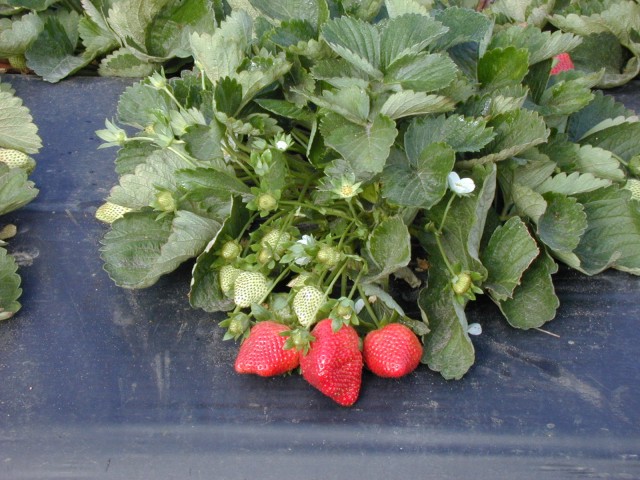
by Matthew Orwat | Oct 21, 2014
Strawberries for the Home Garden
Tuesday October 28, 2014
UF IFAS Extension
Washington County

Learn how to grow strawberries in the Florida fall home garden !
Where: Washington County Ag Center East Wing Conference Room
1424 Jackson Ave. Chipley, FL 32428
When: Tuesday October 28th , 2014 6:00pm-8:00pm
Cost: $10.00. Refreshments Served
Limit 30 participants
Strawberry plant plugs will be provided to participants !
On site demonstration !
Pre Registration required for count: Contact Nikki or Cynthia at 850-638-6180 or email Matthew Orwat at mjorwat@ufl.edu

by Matthew Orwat | Oct 14, 2014

Sweet Charlie Strawberry. Credit: C.K. Chandler, UF IFAS Extension
Now is the time for Northwest Florida gardeners to plant strawberries for bountiful production of fruit beginning in January and continuing into May. The following procedure will lead to a successful strawberry garden if followed:
The best location for strawberry production provides well-drained, moist, sandy soil with substantial organic matter. It must not be too wet. A fertilizer scheme of 2 lbs of a 6-8-8 fertilizer per 100 sq ft should be broadcasted over the plot, and spaded or disked in. Prepare the bed by leveling out the soil. Commonly, a preferred system is the development of a hill system, which entails making a raised bed 6-8 inches high and 24 inches wide. A raised bed can be filled with well-rotted compost mixed at a 50:50 rate with soil. After bed preparation, provide another application of fertilizer in a single, narrowband in the middle of the bed, 4 to 8 inches deep, but DO NOT apply fertilizer directly below the plants, as the fertilizer may burn the young transplants. Do not use fertilizer with more than 6% nitrogen on strawberries, so that they have less chance of burning and greater chance of setting sweet, quality fruit.
Short day, certified disease free plants for Florida such as Sweet Charlie and Camarosa should be purchased from a reputable nursery.
If growing the plants using plastic mulch or grow fabric, put drip irrigation underneath in the form of drip emitters or bubbler type soaker hose.
When setting out the transplants:
- Keep plants moist before planting
- Spread roots out in fan-shape
- Set plants in moist soil at the correct depth. Do not cover the plants crown with dirt or leave its roots exposed above the soil.
- Space plants 12 to 18 inches apart.
- Pack the soil firmly around the roots, then sprinkle with water. Overhead sprinkling may keep the tops from drying out until the roots can get established.
For best results, strawberries should be mulched. Black polyethylene plastic mulch at 1 to 1½ mil thick is best (completely cover the top and sides of bed before planting). Be sure the bed is firm, formed correctly, moist, and fertilized adequately. Place soil on the edges of the plastic to hold it in place. Cut slits in the plastic for the transplants.
When using alternatives like straw, bark or other natural organic materials mulch to a depth of 1 to 2 inches, but do not completely cover the plant.
For more information on growing strawberries contact your local UF IFAS Extenison office or read this publication on strawberry production.
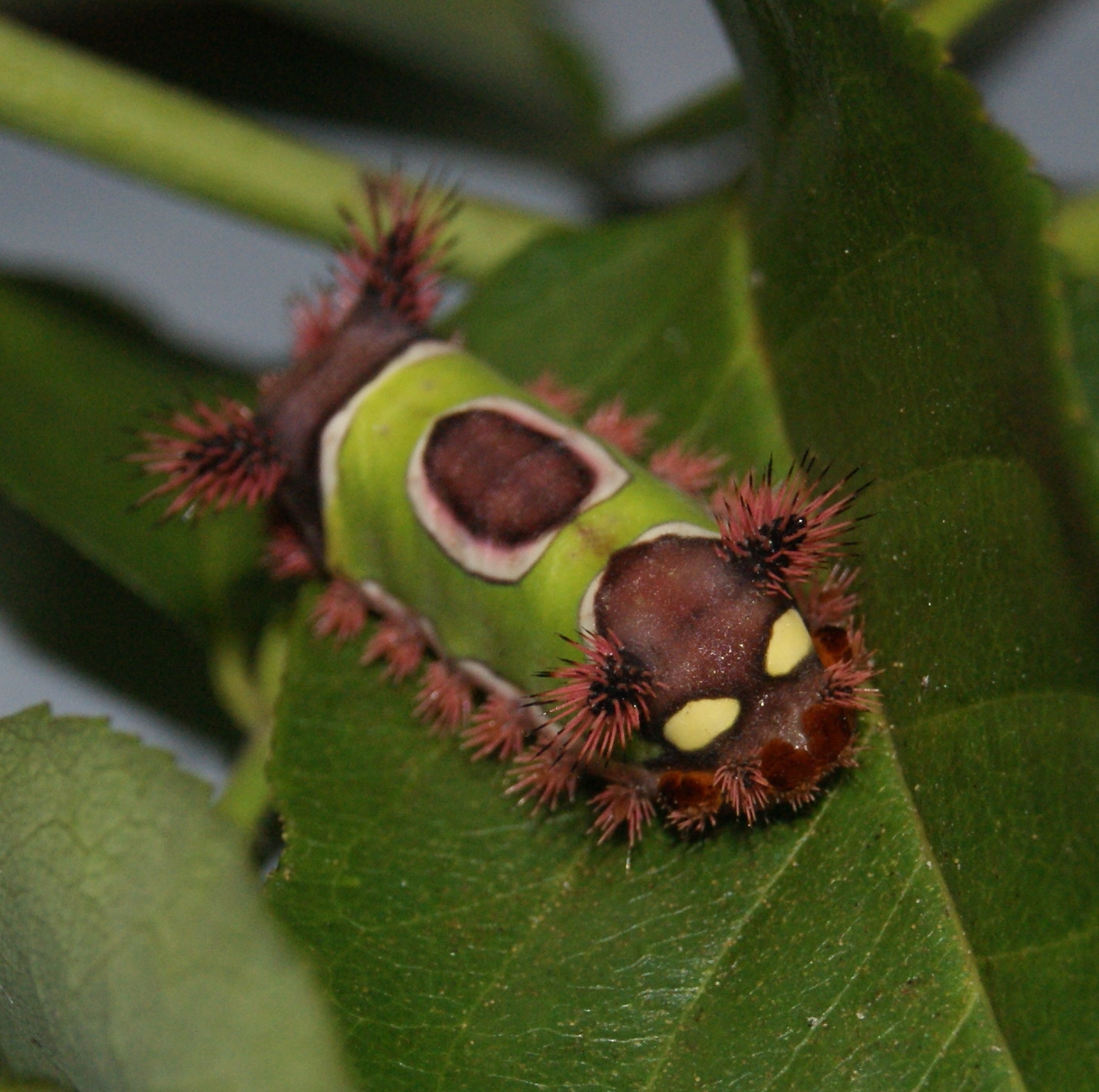
by Matthew Orwat | Sep 30, 2014

Saddleback Caterpillar, Acharia stimulea. Image Credit Matthew Orwat
In Florida, there are a dizzying array of caterpillars that turn into beautiful or interesting moths or butterflies. Most are harmless except to the plants they munch on. There are a few that will cause humans pain if they are handled or touched. One of these venomous caterpillars is called the Saddleback, which is native throughout the eastern United States and is found throughout Florida home gardens. Many caterpillars only feed on specific and limited species of plants. The Saddleback caterpillar, Acharia stimulea, can be found anywhere in the home garden because it eats a wide variety of plants.
This caterpillar is quite a bit shorter than other Lepidoptera and has brown ends covered with venomous spines. The central portion of the body is bright green with a brown dot in the center. The spines on the front and back of the caterpillar are hollow and can break off and embed in the skin when disturbed. They contain hemolytic and vesicating venom, which cause burning sensations on and reddening of the skin; later sweating and blistering. Spines should be removed promptly before any other treatment methods are applied.
The best strategy for managing this insect is prevention of sting. If working in the yard in dense growth where these might not be easily observed, wear gloves and long sleeves. They are not aggressive and very slow moving, so they are easily avoided. Since they are seldom present in large numbers, the preferred method of control is removal from plants with forceps. Registered insecticides, such as those containing Bt (Bacillus thuringiensis), are effective controls of this insect.
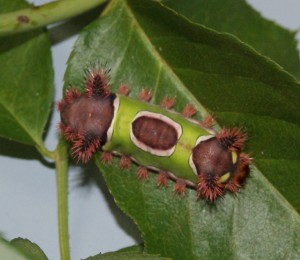
Saddleback Caterpillar, Acharia stimulea. Image Credit Matthew Orwat
- Aster spp.; Helianthus spp., sunflower and artichoke
- Cycas revoluta, cycad, sago ‘palm’
- Vaccinium spp., blueberry, cranberry, huckleberry
- Castanea spp., chestnut; Quercus spp., oak
- Carya illinoinensis, pecan
- Lagerstroemia indica, crape myrtle
- Hibiscus rosa-sinensis, Chinese hibiscus; H. syriacus, rose of Sharon; Malvaviscus spp., wax mallow; Tilia spp., basswood
- Eriobotrya japonica, loquat; Malus pumila, common apple; M. sylvestris, crabapple; Photinia spp.; Prunus serotina, black cherry; Pyrus spp., pear; Rosa spp., rose
- Coffea arabica, mountain coffee; Gardenia spp.; Ixora coccinea, jungle geranium
- Citrus aurantium, bitter orange; C. limonia, rangpur; C. paradisi, grapefruit; C. sinensis, sweet orange; Fortunella spp., kumquat
For more information, please consult with publication # EENY 552 “Saddleback Caterpillar Acharia stimulea” or your local extension office.

by Matthew Orwat | Sep 16, 2014
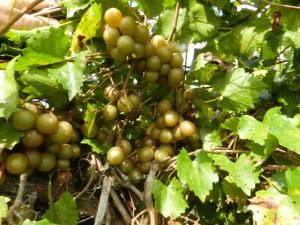
Prolific producing muscadine cultivar ‘Granny Val’ – Image Credit Dr. Peter C. Andersen
Mother always said “never be late” but in the case of certain muscadine (Vitis rotundifolia) cultivars, it’s good to be late.
Although muscadine harvest can begin as early as July, gardeners with late bearing muscadines are still reaping the benefits of fruit harvest and may until early October.
Northwest Florida gardeners often grow muscadines as a substitute for traditional grape (Vitis vinifera) cultivars such as ‘Concord’ or ‘Thompson’s Seedless’, since they are prone to Pierce’s Disease. In fact, muscadines are native to the southwest USA and resistant to a variety of insect and disease pests, so much so that they can be grown in the home garden without the use of insecticides or pesticides.
An additional advantage of gardening with muscadines is that they can easily be asexually propagated. To mimic the natural asexual propagation of wild muscadines, home gardeners may use the pegging method. Pegging entails wounding the branch in several locations, then burying the wounded section of the branch in moist soil while leaving the shoot tip exposed. If this is done in the late spring or summer, roots should form from the main branch in about a month. After roots are confirmed, the connection with the mother plant can be cut.
Planting time for muscadines depends on the type of plant purchased. If gardeners want to plant bare root vines, they should plant them between December and January, but containerized plants can be planted any time.
Before muscadines are planted, soil tests should be performed to determine pH. Muscadines can be grown in the pH range of 5.5 to 7.0, with the optimal level between 6.0-6.5. Since many soils in northwest Florida are highly acidic, tests should be done at least 3 months before planting. This will allow the addition of an optimal lime source Dolomite, which takes 3 months to raise the pH but also adds magnesium to the soil.
If this article prompts the reader to plant muscadines, refer to HS # 753 “The Muscadine Grape” for information about establishment, irrigation and fertilization.
Here is a list of recommended late bearing cultivars to look for when selecting plants.
-
Big Red
-
Delight
-
Doreen
-
Farrer
-
Granny Val
-
Late Fry
-
Nesbitt
-
Polyanna
-
Supreme
-
Pineapple
by Matthew Orwat | Aug 4, 2014
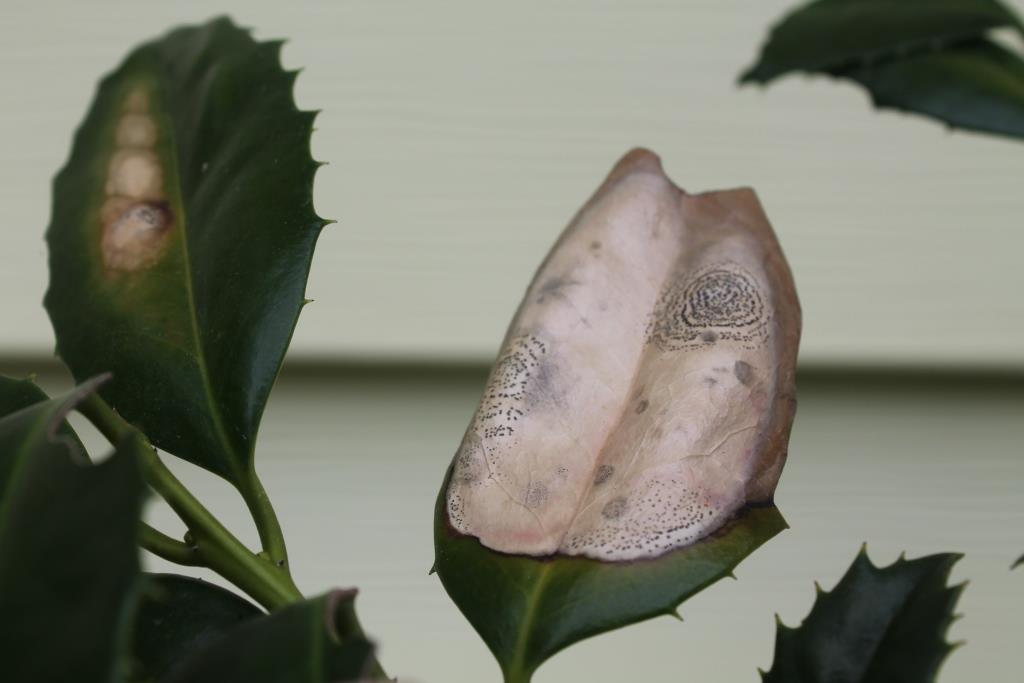
Holly leaf infected with Phyllosticta. Image Credit Matthew Orwat
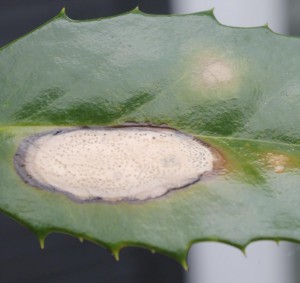
Phyllosticta lesion on holly leaf. Image Credit Matthew Orwat
The high humidity experienced in the Florida Panhandle during July and August has provided perfect conditions for fungal disease development on the leaves of a variety of ornamental species. One particularly noticeable pathogen is Phyllosticta. Fungi of the Phyllosticta spp. often cause large brown lesions on ornamental shrubs and trees such as magnolia, holly, Indian hawthorn, maple, crape myrtle and others. This dark to light brown spots are bordered with maroon, black or yellow rings, dividing the living and dead tissue. Black fruiting bodies, about the size of a pinpoint, are often spread throughout the diseased areas of the leaf. Infected portions of the leaf often drop out, leaving ragged remnants on formerly attractive shrubs.
Although preventative fungicides have been shown to reduce disease incidence, infected plants cannot be cured by sprays. Several mechanical strategies should be put into practice to reduce disease re-occurrence.
- Sanitation: Removal of leaf litter – Dead, diseased leaves contain the fruiting bodies, which will produce new fungal spores if left in the garden
- Thinning of branches – areas with poor air circulation are more prone to Phyllosticta
- Drip irrigation – overhead irrigation enhances the spread of a variety of fungal diseases. If overhead irrigation must be used, it should be done between 5 – 10 a.m.
For additional information about this and other disease, please go to the UF/IFAS U-Scout disease ID site.
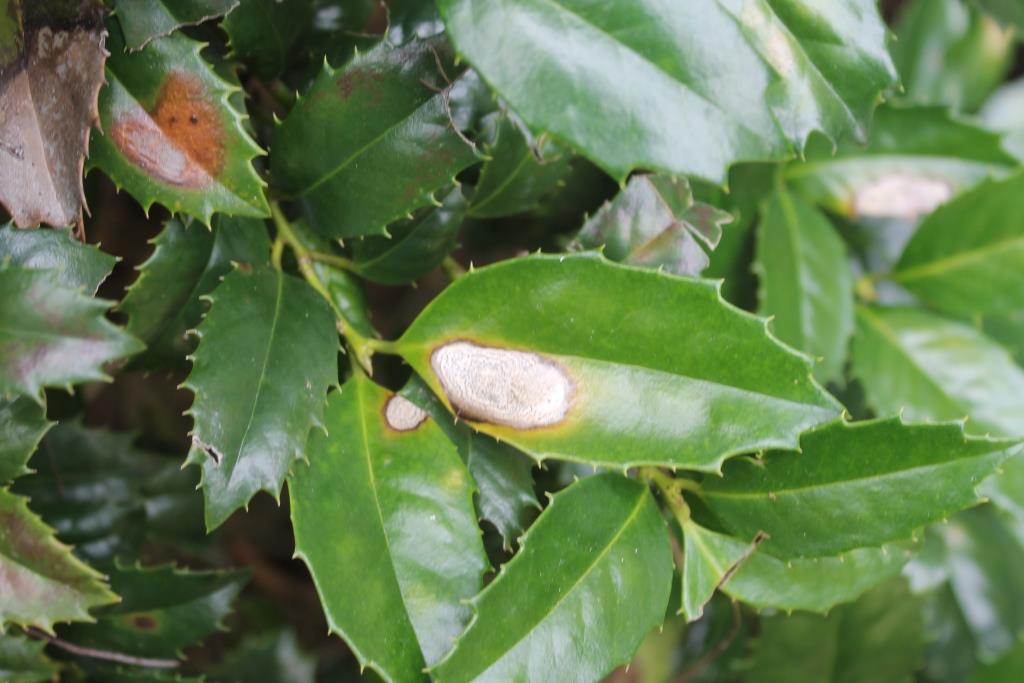
Early statge Phyllosticta. Image Credit Matthew Orwat










